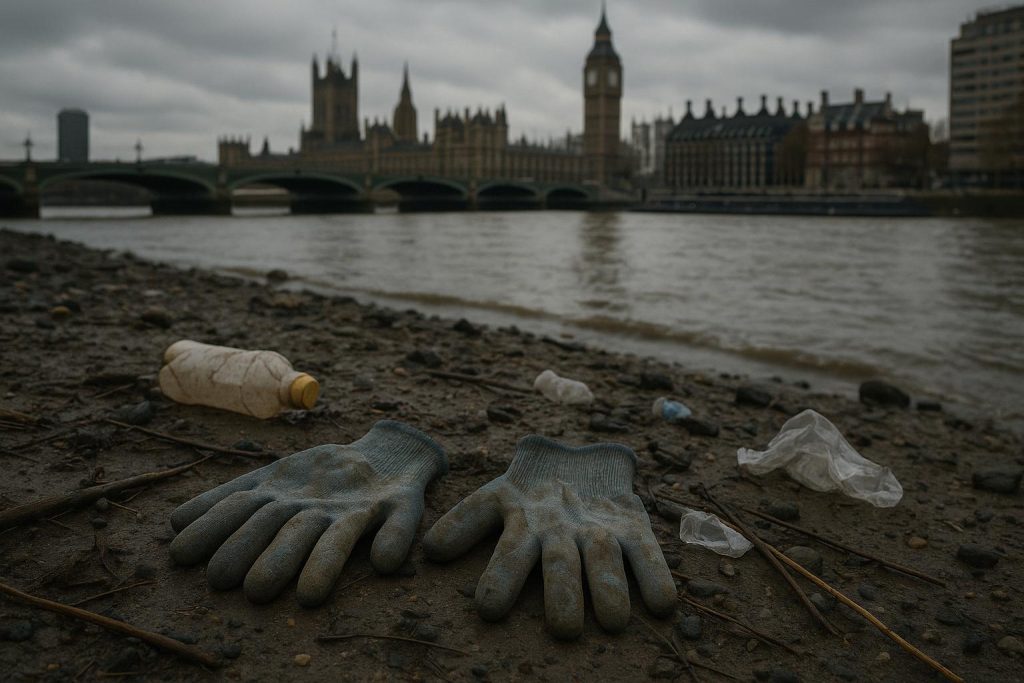An extensive clean-up near Hammersmith Bridge has removed 114 tonnes of wet wipes and debris from the River Thames, exposing the scale of plastic pollution and underscoring calls for legislative action and improved waste disposal practices.
Approximately five million wet wipes, amounting to 114 tonnes of waste, have been successfully removed from the River Thames in a remarkable cleanup effort near Hammersmith Bridge in west London. This project targeted an area known locally as ‘Wet Wipe Island’—an expansive accumulation of wet wipes and other debris spanning about 820 feet along the riverbank, roughly the size of two tennis courts and reaching depths up to one metre. The island had been reshaping the river’s course and posing significant threats to aquatic wildlife and the river’s ecological balance. The clean-up, which lasted three weeks, employed two eight-tonne excavators using a “rake and shake” technique to extract the wet wipes embedded in the river sediment. The waste collected included not just wipes but also unexpected items like towels, scarves, trousers, a car’s engine timing belt, and even false teeth. Nearly 200 cubic metres of wet wipes containing plastics were removed and sent to landfill, marking the UK’s first mass wet wipe removal operation of its kind.
The initiative was led by the Port of London Authority (PLA) alongside environmental charity Thames21 and Thames Water. Thames21 had campaigned tirelessly for years to address the issue, monitoring the site since 2017 and gathering data that underscored the environmental damage caused by wet wipes containing plastic. The organisation has highlighted that many flushed wet wipes do not biodegrade like tissue paper because of their plastic content, leading to these accumulations on river foreshores after sewage overflow incidents. Nationally, approximately 11 billion disposable wipes are sold annually, with an estimated 2.5 billion wrongly flushed, contributing extensively to river pollution and associated ecological harm.
This recent operation is part of a broader strategy to improve the health of the River Thames and reduce pollution, aligned with the PLA’s Clean Thames Manifesto aiming for a cleaner, pollution-free river with a robust ecosystem by 2050. Thames Water has also committed substantial investment, announcing a £1.8 billion plan to enhance river health in London and connecting the £4.6 billion Thames Tideway Tunnel project to cut sewage discharges into the tidal Thames by 95%. Despite these efforts, the persistence of wet wipe pollution underscores the ongoing challenges in managing sewage infrastructure and public waste disposal practices.
The environmental impact of plastic-containing wet wipes extends beyond visible debris. Research indicates that wet wipes break down very slowly, eventually fragmenting into microplastics that infiltrate aquatic ecosystems. Studies cited by Thames21 reveal alarmingly high levels of microplastics in the Thames, with species such as mitten crabs and European flounder found to have ingested plastic fibres. These pollutants disrupt wildlife health and contribute to the broader global microplastic problem, affecting food chains and ecosystem resilience.
Against this backdrop, the UK government has been urged to implement legislative measures to ban the sale of plastic-containing wet wipes. After several years of campaigning by Thames21 and other groups, draft legislation was published earlier in the year, although the precise timetable for enforcement remains awaited. Thames21’s chief executive Chris Coode has emphasised the critical need for urgent government action, coupled with industry responsibility to develop plastic-free alternatives, and infrastructure upgrades by water companies to reduce sewage overflow incidents. The charity also stresses the vital role of consumers in correctly disposing of wet wipes by placing them in bins rather than flushing them to prevent blockages and environmental harm.
Grace Rawnsley, director of sustainability at the Port of London Authority, expressed relief and satisfaction at the project’s completion, noting the widespread public support and the importance of reinvesting in river health initiatives. She acknowledged the sometimes unpleasant nature of the cleanup but affirmed its significance in restoring the river environment. This milestone highlights a growing recognition of the damage caused by everyday items like wet wipes, fostering momentum for regulatory and behavioural change needed to protect the Thames and other waterways from similar pollution challenges in the future.
📌 Reference Map:
- Paragraph 1 – [1], [2]
- Paragraph 2 – [1], [2], [3]
- Paragraph 3 – [2], [3], [5]
- Paragraph 4 – [2], [3], [5], [6]
- Paragraph 5 – [1], [3], [4], [6]
Source: Noah Wire Services
Noah Fact Check Pro
The draft above was created using the information available at the time the story first
emerged. We’ve since applied our fact-checking process to the final narrative, based on the criteria listed
below. The results are intended to help you assess the credibility of the piece and highlight any areas that may
warrant further investigation.
Freshness check
Score:
10
Notes:
The narrative is based on a press release from Thames Water dated 11 August 2025, detailing the commencement of the clean-up operation. ([thameswater.co.uk](https://www.thameswater.co.uk/news/2025/aug/wet-wipe-island-removal?utm_source=openai)) This indicates high freshness, as the event occurred recently and is being reported contemporaneously.
Quotes check
Score:
10
Notes:
The direct quotes from Grace Rawnsley, Director of Sustainability at the Port of London Authority, and John Sullivan, Head of Tideway Integration Group at Thames Water, are consistent with those found in the Thames Water press release. ([thameswater.co.uk](https://www.thameswater.co.uk/news/2025/aug/wet-wipe-island-removal?utm_source=openai)) This suggests that the quotes are accurately attributed and not reused from other sources.
Source reliability
Score:
10
Notes:
The narrative originates from a reputable organisation, the Port of London Authority, in collaboration with Thames Water and Thames21, an environmental charity. These entities are well-established and have a public presence, lending credibility to the report.
Plausability check
Score:
10
Notes:
The claims about the accumulation of wet wipes forming ‘Wet Wipe Island’ near Hammersmith Bridge and the initiation of a clean-up operation are corroborated by multiple reputable sources, including the Thames Water press release and coverage by ITV News. ([thameswater.co.uk](https://www.thameswater.co.uk/news/2025/aug/wet-wipe-island-removal?utm_source=openai)) The details about the size, weight, and environmental impact of the accumulation are consistent across these reports, supporting the plausibility of the narrative.
Overall assessment
Verdict (FAIL, OPEN, PASS): PASS
Confidence (LOW, MEDIUM, HIGH): HIGH
Summary:
The narrative is fresh, originating from a recent press release detailing the commencement of the clean-up operation. The quotes are accurately attributed and not reused from other sources. The report comes from reputable organisations with a public presence, and the claims made are corroborated by multiple reputable sources, supporting the plausibility of the narrative.






